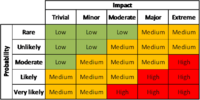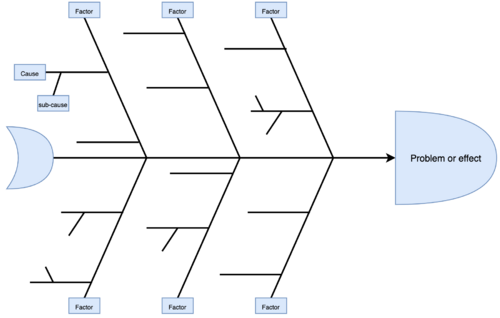Fishbone Diagram for Root Cause Analysis
Abstract
The major cause of uncertainty in organizations is risk. It is crucial to be able to identify those risks and manage them before it can have an impact on the organization’s objectives. The Fishbone diagram, also known as the Ishikawa diagram or the cause-and-effect diagram. was created by Kaoru Ishikawa in the 1960s. It is a visual tool used to identify the possible causes to a problem or effect with the practice of brainstorming. The shape of the diagram resamples the side view of a fish skeleton, hence the name Fishbone diagram [1]. The Fishbone diagram sorts ideas into useful categories and can be helpful in identifying areas for improvement and possible causes that might not be considered using other tools.
This article will examine the use of the Fishbone diagram in Risk Management, an overview of the tool and a step-by-step guide to develop a Fishbone diagram, including models and other tools that can be combined in the process.
Contents |
The Big Idea: Fishbone Diagram
According to the PMBOK® Guide the technique of The Fishbone Diagram is used in both the Manage Quality process and the Control Quality process [2] (p.293, 304), but the tool can also be used to identify the risks associated with a project. In Risk Management, The Fishbone diagram, also called cause-and-effect diagram or Ishikawa diagram is used in risk identification to identify the many potential causes (root cause analysis) for an effect or problem and can be practical in sorting ideas into useful categories through brainstorming sessions [3].
Risk management is the process of identifying, monitoring and managing the potential risks to all levels of the organization, from portfolios through programs, projects, and operations. Uncertainty in organizations is inevitable but risk management can provide information to limit the impact of uncertainty to the organization objectives. Individual risk can have a positive effect and a negative effect on objectives and is described as an uncertain event or condition. To assess how serious the risk is to the organization they need to consider both uncertainty, often described as probability, and the effect, often referred to as impact, on objectives [4]. Identifying risks from risk-related features is important. “Causes are events or circumstances that currently exist or are certain to exist in the future, which might give rise to risks. Effects are conditional future events or conditions that directly affect one or more objectives if the associated risk occurs” [4] (p. 11).
Risk Identification is one of the processes in Risk Management. In Project Risk Management the focus is on anticipating the, and with management increase opportunities and decrease threats that could impact the success of the project [4] (p. 57). Risk Identification is described as “The process of identifying individual project risks as well as sources of overall project risk, and documenting their characteristics” [2].
There can be more than one cause and one effect in risks and the Fishbone diagram can assist organizations to identify those possible causes for a problem or effect. The diagram identifies possible causes of the problem or effect and helps organization identify the root cause of the problem. When all root causes have been removed, the problem is solved. The tool was created by Kaoru Ishikawa in the 1960s who also defined the 7 quality management tools. He did not invent them all but was the first to combine them all in order to solve problems.
Application: Fishbone Diagram
In this section a step-by-step guide to develop a Fishbone diagram, including useful models and methods.
Step 1: Identify the problem
The first step for the team is to define a problem or effect that the team wants to analyze. For a successful Fishbone diagram, it is critical to define the problem correctly. Have the team think consider and identify who is involved, what the problem is, and when and where it occurs. When the problem has been identified it is written in a box on the center right-hand side with a horizontal arrow running to it, e.g., on a large sheet of paper or whiteboard. It is also possible to write the problem statement on the center left hand side, whichever you prefer. Resembling a head and spine of a fish, this layout, will give you space to develop ideas in the next steps [5].
Step 2: Work out the Major Factors Involved
In the next step the team identifies the factors involved in the problem or effect using brainstorming techniques. An example of these factors is Site, Task, People, Equipment and Control. To achieve the best outcome, try to identify as many of these factors as possible. Then, they are written down as branches off the spine of the diagram and resemble the bones [5].
Useful models
To help in this step of the diagram, teams often use common models of root causes/factors:
5M used in the Fishbone diagram - mainly for Manufacturing [6].
- Method (Assembly line)
- Mother Nature (Ambient humidity problems)
- Man (Teaching a single employee to find the defect)
- Machine (Age)
- Materials (Hard materials)
This method is also known as the 6 M method with the addition of Measurement.
8Ps used in the Fishbone diagram - mainly for Product Marketing [6].
- Product
- Place
- Price
- People
- Promotion
- Physical Evidence
- Process
- Performance
4Ss used in the Fishbone diagram - mainly used in the service industries [6].
- Suppliers
- Surroundings
- Systems
- Skills
Step 3: Identify Possible Causes
In the third step, the team identifies the possible causes associated to each factor determined in the previous step. Again, the team should use brainstorming techniques to identify these causes, and if the problem or effect is large/complex it may be effective to also break down the causes into sub-causes. Have the team think about “Why does this happen?”. Then, the causes and sub-causes are written down as lines coming off each factor branch. If the cause applies to more than one factor it can be added to several branches [5].
The 5 Why's
The approach of “Five Whys” can be used as a tool for this part, it refers to the practice of asking. The team should ask themselves "Why?", five times, and include the answers/ideas as causes in the Fishbone diagram [7].
Step 4: Analyze Your Diagram
At this stage of the Fishbone diagram all the possible causes that the team has been able to identify should be shown with the problem or effect. Then, the team can look into the causes they assume are most likely to impact, and inspect them further, e.g., by conducting a survey [5].
Risk Analysis
Risk probability and impact assessment is a tool in the process of performing qualitive risk analysis and can be useful to the team in the last step of the Fishbone diagram. The process assesses the priority of the identified project risks and can be represented in a Probability and impact matrix [2].

Limitations
Like all other tools the Fishbone diagram has some limitations. How successful the diagram is depends largely on the team involved in the process. If team members are not skilled and experienced the chance of an effective and informing results is not great. But still, even with skilled and experienced team members the diagram does not single out the root cause of the problem or affect analyzed. All of the identified causes need to be analyzed and some of them might even have little effect on the problem. The brainstorming part of the diagram also has some limitations. With brainstorming the diagram is based on opinions rather than evidence. It is a time-consuming process and often not all team members contribute equally to the process. Overall, the results of the Fishbone diagram clearly identify the possible causes of the problem but does not solve the problem. Other tools or methods are needed to further analyze each cause and solve the problem itself.
Annotated bibliography
Cause and Effect Analysis using the Ishikawa Fishbone & 5 Whys This article provides an overview of the Fishbone diagram, the steps involved combined with the 5 Why's method.
Guide to the Project Management Body of Knowledge This book provides thorough description of Project Management and information on Risk Management and all processes involved.
Cause and Effect Analysis This article provided a good step-by-step guide to the Fishbone diagram tool.
Standard for Risk Management in Portfolios, Programs, and Projects This book addresses Risk Management in Portfolios, Programs, and Projects.
References
- ↑ Quality tools: fishbone diagram. Design Buildings Wiki. https://www.designingbuildings.co.uk/wiki/Home
- ↑ 2.0 2.1 Project Management Institute, Inc.. (2017). Guide to the Project Management Body of Knowledge (PMBOK® Guide) (6th Edition). Project Management Institute, Inc. (PMI). Retrieved from https://app.knovel.com/hotlink/toc/id:kpGPMBKP02/guide-project-management/guide-project-management
- ↑ Fishbone Diagram. ASQ. https://asq.org/quality-resources/fishbone
- ↑ 4.0 4.1 4.2 Project Management Institute, Inc. (PMI). (2019). Standard for Risk Management in Portfolios, Programs, and Projects - 7.1.3 Project Risk Response Strategies. Project Management Institute, Inc. (PMI). Retrieved from https://app.knovel.com/hotlink/pdf/id:kt011VVUA4/standard-risk-management/project-risk-response
- ↑ 5.0 5.1 5.2 5.3 Cause and Effect Analysis. MindTools. https://www.mindtools.com/pages/article/newTMC_03.htm
- ↑ 6.0 6.1 6.2 A complete Guide for Fishbone Diagram (Ishikawa Diagram).EdrawMax Online. https://www.edrawmax.com/fishbone-diagram/
- ↑ Cause and Effect Analysis using the Ishikawa Fishbone & 5 Whys. City Process Management. http://www.cityprocessmanagement.com/Downloads/CPM_5Ys.pdf
- ↑ Probability And Impact Matrix. Just Get PMP. http://www.justgetpmp.com/2012/02/probability-and-impact-matrix.html
